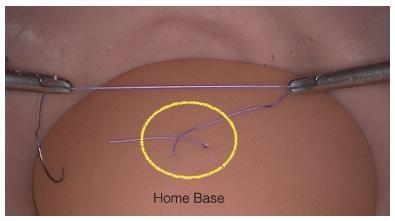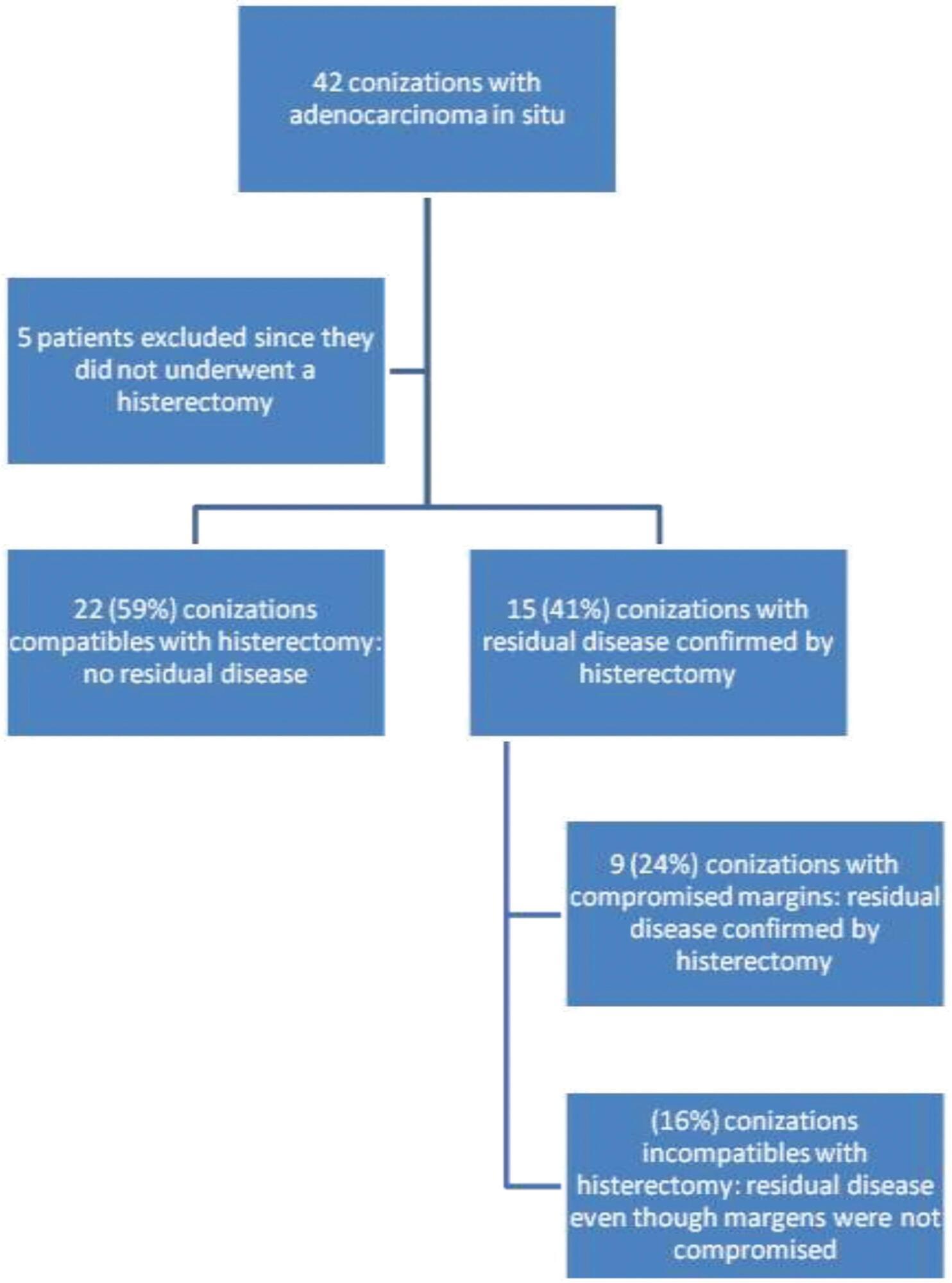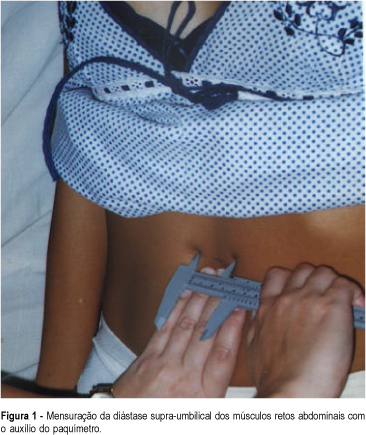Summary
Revista Brasileira de Ginecologia e Obstetrícia. 2018;40(5):266-274
To assesswhether themonomanual or bimanual training of laparoscopic suture followingthe sametechniquemay interferewith theknots’ performancetimeand/or quality.
A prospective observational study involving 41 resident students of gynecology/ obstetrics and general surgery who attended a laparoscopic suture training for 2 days. The participants were divided into two groups. Group A performed the training using exclusively their dominant hand, and group B performed the training using both hands to tie the intracorporeal knot. All participants followed the same technique, called Romeo Gladiator Rule. At the end of the course, the participants were asked to perform three exercises to assess the time it took them to tie the knots, as well as the quality of the knots.
A comparative analysis of the groups showed that there was no statistically significant difference (p = 0.334) between them regarding the length of time to tie one knot. However, when the time to tie 10 consecutive knots was compared, group A was faster than group B (p = 0.020). A comparison of the knot loosening average, in millimeters, revealed that the knots made by group B loosened less than those made by group A, but there was no statistically significant difference regarding the number of knots that became untied.
This study demonstrated that the knots from group B showed better quality than those from group A, with lower loosening measures and more strength necessary to untie the knots. The study also demonstrated that group A was faster than B when the time to tie ten consecutive knots was compared.

Summary
Revista Brasileira de Ginecologia e Obstetrícia. 2023;45(5):266-272
This study analyzes the role of clinical simulation in internal medical residency programs (IMRP) in Obstetrics and Gynecology (OB/GYN), attributed by the supervisors, in the training of residents in the city of São Paulo (SP).
Cross-sectional descriptive, qualitative, and exploratory approach. Semi-structured interviews were performed with ten supervisors of Medical Residency programs in Obstetrics and Gynecology. Interviews were analyzed by means of content analysis under the thematic modality, starting with the core the role of clinical simulation in Obstetrics and Gynecology Medical Residency Programs.
Supervisors view Clinical simulation as: a complementary tool for the teaching and learning process, a possibility of a safe teaching and learning environment, an opportunity to learn from mistakes, a support for professional practice committed to patient safety, a learning scenario for teamwork, a scenario for reflection on the work process in Obstetrics and Gynecology, a scenario for evaluative processes in the medical residency. Still according to supervisors, Clinical Simulation favors decision-making and encourages the resident participation in activities.
Supervisors recognize Clinical Simulation as a powerful pedagogical tool in the learning process of resident doctors in Obstetrics and Gynecology Residency Programs.
Summary
Revista Brasileira de Ginecologia e Obstetrícia. 2020;42(5):266-271
To observe if the histopathological result of a conization performed after cervical adenocarcinoma in situ diagnosis is compatible with the histopathological analysis of a subsequent hysterectomy.
The present descriptive and observational research consisted of the analysis of the medical records of 42 patients who were diagnosed with in situ adenocarcinoma postconization. The analysis consisted of whether there was compatibility between the histopathological reports of conization and hysterectomy and if there was an association between adenocarcinoma in situ and another neoplasia (squamous disease). Interpretation of any immunohistochemistry reports obtained was also performed. In addition, clinical and epidemiological data were also analyzed.
A total of 42 conizations were performed, 33 (79%) were cold knife conizations and 9 (21%) were loop electrosurgical excision procedures (LEEPs). Of the patients analyzed, 5 (10%) chose not to undergo subsequent hysterectomy to preserve fertility or were < 25 years old. Out of the 37 patients with adenocarcinoma in situ who underwent subsequent hysterectomy, 6 (16%) presented with residual disease. This findingprovedincompatiblewiththe finding of the conizations, which had ruled out invasive cancer.
The prevalence of adenocarcinoma in situ increased in the past years. There is still a large part of the medical literature that advocates the use of conservative treatment for this disease, even though it is common knowledge that it is a multifocal disease. However, the majority of studies advocate that hysterectomy should remain the preferred treatment for women who have already completed their reproductive purpose.

Summary
Revista Brasileira de Ginecologia e Obstetrícia. 2016;38(6):266-272
Some studies have investigated the influence of hormonal deficits and menopausal status in muscle disorders of women. However, it has not been investigated the relationship of both climacteric symptoms and the perception of quality of life with physical performance.
To evaluate the correlation of menopausal symptoms and quality of life with physical performance in middle-aged women.
This cross-sectional study was performed from April to November 2013 in the municipality of Parnamirim, in the Brazilian state, Rio Grande do Norte. The sample was composed of 497 women aged 40-65 years. The Menopause Rating Scale (MRS) and the Utian Quality of Life (UQOL) questionnaire were used to evaluate menopausal symptoms and quality of life respectively. Measures of physical performance included handgrip strength, knee extensor and flexor strengths (using an isometric dynamometer), gait speed, and chair stand test. The correlation between menopausal symptoms and quality of life with physical performance was assessed by Pearson's correlation coefficient with significance set at p< 0.05 and a confidence interval of 95 %.
There was a significant negative correlation between handgrip strength and somatic MRS score (p= 0.002) and total MRS score (p= 0.03). There was a significant correlation between knee flexor strength and sit-to-stand time and all menopausal symptom areas (p< 0.05), except psychological symptoms. There was a positive correlation between physical performance of the knee flexors and quality of life items including occupational (p= 0.001), emotional (p= 0.005), and total UQOL (p= 0.01) , but a negative correlation with sit-to-stand time and all quality of life domains (p< 0.05).
A greater intensity of menopausal symptoms and worse quality of life were related with worse physical performance. Thus, preventive measures should be implemented to avoid adverse effects on physical performance at more advanced ages.
Summary
Revista Brasileira de Ginecologia e Obstetrícia. 2015;37(6):266-271
DOI 10.1590/SO100-720320150005254
To investigate the relationship between sexual function and quality of life in
pregnant women living in two cities of Northeastern Brazil.
The sample consisted of 207 pregnant women. The data were collected through a
questionnaire containing questions about socio-demographic, gynecological and
obstetrical data, body and sexual knowledge. Quality of life was assessed by
applying the Ferrans & Powers Quality of Life Index (QLI Ferrans and Power).
Sexual function was assessed using the Female Sexual Function Index (IFSF). Data
were statistically analyzed using the Shapiro-Wilk, Mann-Whitney and Wilcoxon
tests.
The pregnant women studied had a median age of 30 years (quartile 26-33 years)
and were approximately at the 26th gestational week. A significant
decrease in the monthly frequency of sexual relations of the couple was observed,
with a median of 12 to 4 times per month (Z=-10.56; p<0.001). Sexual
dysfunction was detected in 35.7% of the pregnant women studied, whose quality of
life was lower when compared to women with unchanged sexual function (Z=-2.9;
p=0.004).
The results of this study show that sexual dysfunction negatively affected the
quality of life of pregnant women, and this should be an important aspect for
review during prenatal consultations.
Summary
Revista Brasileira de Ginecologia e Obstetrícia. 1999;21(5):267-272
DOI 10.1590/S0100-72031999000500004
Purpose: to check if physiotherapy immediately after childbirth may contribute to early diastasis reduction. Methods: longitudinal and randomized study with 50 parturient women recruited in the Maternidade-Escola Hilda Brandão of the Santa Casa of Belo Horizonte, from April to September 1998. The control group (N = 25) was submitted to evaluation and measurement (6 h and 18 h after labor), and the treatment group (N = 25) was submitted to the same evaluation and measurement as above, as well as to a protocol for physiotherapeutic assistance, 6 and 18 h after labor. For the evaluations, a pachymeter, a precision instrument, was used to measure diastasis. Results: at 18 h after parturition, the control group presented a diastasis reduction of 5.4%, and the treatment group of 12.5%, as related to the first measure (6 h after delivery) (p<0.001, with a confidence interval of 99%). Conclusions: these results show that the physiotherapeutic assistance immediately after childbirth determines a significant reduction in the diastasis of the recti abdominis muscles (DRAM) after every treatment session, as well as a relevant reduction when compared to the control group, positively contributing to the earlier recovery of the recti abdominis muscles.

Summary
Revista Brasileira de Ginecologia e Obstetrícia. 1998;20(5):267-271
DOI 10.1590/S0100-72031998000500006
Objective:To analyze the levels of endogenous sexual steroids and gonadotrophin in women with and without endometrial cancer. Methodology:We developed a clinical comparative study on 20 postmenopausal women with endometrial cancer and 20 postmenopausal women without endometrial cancer. The age, the postmenopausal time and the index of body mass were used as matching variables. The plasma levels of the endogenous sexual steroids were measured using radioimmunoassay and immunoenzymatic methods. For the statistic analysis we used the Student's t test. Results: The levels of androstenedione (A), total testosterone (t) and free testosterone (TL) were higher in the women with endometrial cancer, and those of the luteinic hormone (LH) were significantly lower values in these women. We also observed that the ratio (E1/A) showed significantly lower in the group of women with cancer, while the ratio (E2/E1) did not present any differences between groups. Conclusions: We emphasize the potentiality of sexual steroids and gonadotrophins in the genesis of endometrial adenocarcinoma in postmenopausal women.